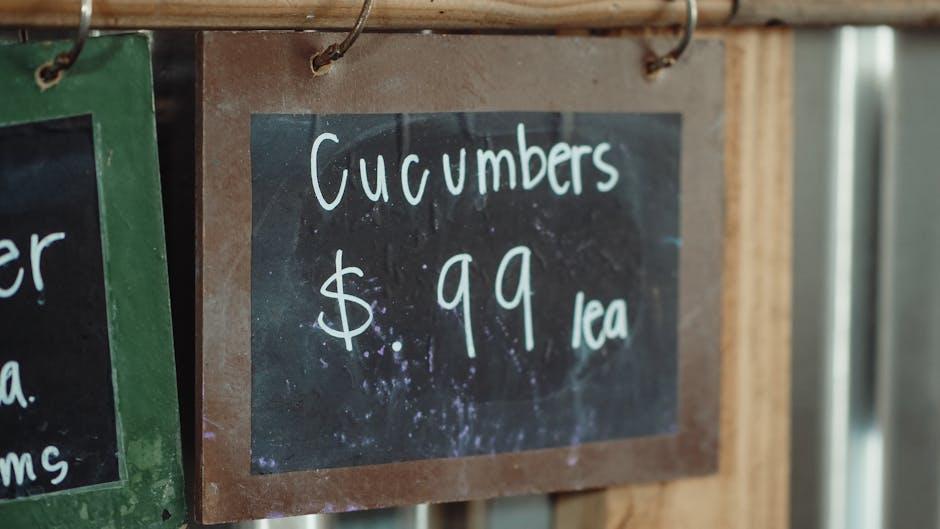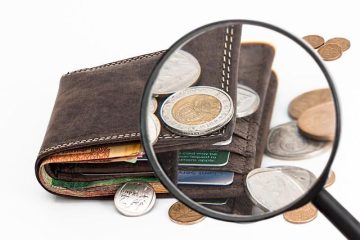Table of Contents
- Understanding the Basics of a Food Budget Game
- Strategies for Stretching Your Food Budget Effectively
- Engaging the Family: Making Budgeting Fun and Interactive
- Essential Tools and Apps to Enhance Your Food Budget Game
- Tips for Sustaining Long-Term Budget Success
- Q&A
- The Conclusion


Understanding the Basics of a Food Budget Game
The concept of a food budget game revolves around teaching individuals how to effectively manage their grocery expenses while making healthy food choices. This engaging activity encourages participants to simulate real-life budgeting scenarios where they allocate a fixed amount of money for grocery shopping. By doing so, they can identify which items are essentials and which are luxuries, enhancing their decision-making skills in an enjoyable way.
To make the game more interactive, players can be divided into teams, each tasked with creating a diverse shopping list within a set budget. Here are some categories to consider including in your budget planning:
- Fruits and Vegetables: Fresh produce is crucial for nutrition.
- Proteins: Include affordable sources like beans, eggs, and chicken.
- Grains: Whole grains, pasta, and rice should be budget staples.
- Dairy (or alternatives): Consider milk, yogurt, and cheese.
- Snacks and Treats: Allow a small portion for occasional indulgence.
An essential aspect of this game is the incorporation of challenges that reflect real-world constraints. For instance, implementing limitations such as dietary restrictions or preferences can provide deeper insights into meal planning. Players can also compare their chosen items against the actual prices in local grocery stores, using a simple table format to outline their selections:
| Item | Estimated Cost | Essential (Yes/No) |
|---|---|---|
| Spinach | $2.50 | Yes |
| Chicken Breast | $8.00 | Yes |
| Chips | $3.00 | No |
| Almond Milk | $2.80 | Yes |
This practical exercise allows players to experience the challenges of budgeting while fostering creativity and collaboration. By the end of the game, participants will not only have developed a better understanding of how to allocate their food budget but also gain insights into making healthier food choices that fit their financial reality.


Strategies for Stretching Your Food Budget Effectively
Stretching your food budget doesn’t mean sacrificing quality or flavor; it’s about strategizing for maximum efficiency. Start by planning your meals for the week. Create a specific list of dishes you want to cook, which should be based on both sales and seasonal ingredients. Not only does meal planning prevent impulse purchases, but it saves time and reduces food waste. Consider utilizing bulk buying for staples such as rice, pasta, and canned goods. This can lead to significant savings over time, especially if you purchase items that have a long shelf life.
When shopping, embrace the art of flexibility. If a recipe calls for a particular ingredient that’s out of your budget or unavailable, look for budget-friendly substitutes. For instance, use frozen vegetables instead of fresh ones or opt for a different protein source like beans instead of meat. Remember to check your pantry before you shop; making meals from items you already have can prevent needless expenses. Take advantage of sales and loyalty programs offered by grocery stores, which can enhance your savings further.
Don’t hesitate to get a bit creative with your cooking techniques. Try incorporating more meatless meals or one-pot dishes, as these can be lighter on your wallet without compromising nutrition. Batch cooking allows you to prepare larger quantities of food that can be easily frozen for future use; this way, you can avoid the temptation to eat out on busy nights. Lastly, always keep an eye on local food co-ops or markets for fresh produce, as buying directly from farmers can often lead to lower prices and better quality.


Engaging the Family: Making Budgeting Fun and Interactive
Transforming budgeting into an engaging family activity can truly change how everyone views finances. Start by creating a fun game around shopping and food expenses. This can be done by assigning each family member a specific role—like the shopper, the accountant, or the meal planner. Incorporate elements like point systems or reward tokens for staying within the budget or for creative meal planning. Each week, after meals are prepared, gather everyone to discuss how well they stuck to their allocated food budget, celebrating successes and learning from challenges.
To pique everyone’s interest, consider adding some competitive spirit. Set up a weekly challenge where each family member must come up with a meal plan that totals no more than a set budget. Use a simple table to track the entries:
| Family Member | Meal Plan Total | Bonus Points Earned |
|---|---|---|
| Mom | $45 | 10 |
| Dad | $38 | 15 |
| Child 1 | $50 | 5 |
| Child 2 | $30 | 20 |
To keep the momentum going, make it visually appealing and interactive. Create a colorful budget board in your kitchen or living area where everyone can see the progress. Include sections for favorite recipes, savings achieved, and upcoming challenges. This not only serves as a reminder of your goals but also sparks conversations about money management and instills essential financial literacy. Engaging in this way makes budgeting less of a chore and more of a team effort, reinforcing values of cooperation, creativity, and mindfulness about spending within the family unit.


Essential Tools and Apps to Enhance Your Food Budget Game
Mastering your food budget requires not just awareness but also the right tools to streamline your efforts. Budget tracking apps can make a significant difference by offering visual insights and easy-to-navigate interfaces. Popular options include:
- Mint: A versatile app that not only helps you manage your food expenses but also offers budgeting features for other categories.
- Yummly: Ideal for meal prepping, this app pairs recipes with nutrition information, allowing you to plan meals based on your budget.
- Grocery Pal: This handy tool can help you find sales and coupons at stores near you, ensuring you always get the best deal.
In addition to budgeting and planning, employing meal planning tools can cut down on impulse buys and unnecessary spending. These tools can assist in organizing your shopping list effectively. Check out:
- Plan to Eat: A subscription-based service that allows you to organize recipes, create meal plans, and generate shopping lists seamlessly.
- Eat This Much: This app generates meal plans based on your dietary preferences and budget constraints, making it easy to stick to your goals.
Analytics play an essential role in understanding your spending habits. Utilizing spending analysis tools can provide insights into where your money goes. Consider using:
| Tool | Features |
|---|---|
| Slice: | Tracks grocery purchases and analyzes spending habits for better budgeting. |
| AnyList: | A collaborative list-making app that includes features for budgeting and sharing lists with family. |
By integrating these essential apps and tools into your routine, you can not only keep a tighter grip on your food budget but also develop healthier buying habits that last.


Tips for Sustaining Long-Term Budget Success
Establishing a robust food budget requires a proactive approach that includes regular monitoring and adjustment. One effective strategy is to review your spending habits weekly. This not only helps identify areas where you can cut costs but also reinforces your budget goals, creating a more mindful shopping experience. Consider keeping a record of each grocery trip in a dedicated app or a simple spreadsheet, allowing for quick reference and adjustments based on your findings.
Furthermore, embracing meal planning can significantly enhance your budgeting efforts. By taking the time to plan your meals for the week ahead, you can create a precise shopping list that minimizes impulse buys. Focus on seasonal ingredients and explore various recipes that incorporate similar elements to reduce waste and enhance versatility. Here are some tips for effective meal planning:
- Choose versatile staples: Items like rice, beans, and oats can serve multiple meals.
- Batch cook: Prepare larger quantities and portion meals to save time and costs.
- Stick to a theme: Assign each day a specific theme (e.g., Meatless Monday) to simplify planning.
Lastly, don’t hesitate to reevaluate your budget periodically. As prices fluctuate and dietary preferences change, your budget should adapt accordingly. Consider dedicating time each month to assess what you spent versus what you planned. Here’s a simple table you can use to compare your budget and actual spending:
| Category | Budgeted Amount | Actual Spending | Difference |
|---|---|---|---|
| Groceries | $300 | $290 | $10 |
| Snacks | $50 | $60 | -$10 |
| Meals Out | $100 | $80 | $20 |
Keeping this table updated will provide you with clear insights into your financial health regarding food expenses, helping you stay on track for long-term success.
Q&A
Q&A: Understanding the Food Budget GameQ1: What is the Food Budget Game? A1: The Food Budget Game is a fun and interactive tool designed to help individuals and families learn how to manage their food expenses effectively. Participants are given a limited budget and challenged to create nutritious meal plans, purchase ingredients, and make choices that ensure they stay within their financial limits. It’s an engaging way to enhance budgeting skills while prioritizing healthy eating.Q2: Who can benefit from playing the Food Budget Game? A2: The Food Budget Game is ideal for anyone looking to improve their financial literacy around food spending. It’s particularly beneficial for students, young adults, families, and even seasoned cooks who want to rein in their grocery costs. Moreover, it serves as an educational tool for community workshops focused on nutrition and budgeting.
Q3: How can I get started with the Food Budget Game? A3: To start playing, gather a group of friends or family. Decide on the budget you want to simulate—this could range from a weekly allowance to a monthly one. Create a list of staple ingredients and prices or access local grocery store flyers to get realistic price points. Then, take turns creating meal plans based on your allocated budget while considering nutritional value and personal preferences.
Q4: What are some strategies to succeed in the Food Budget Game? A4: Success in the Food Budget Game often involves a blend of planning and creativity. Here are a few strategies:
- Meal Prep: Plan meals ahead of time to minimize last-minute decisions that can lead to overspending.
- Buy in Bulk: Purchasing non-perishable items in bulk can save money in the long run.
- Embrace Seasonal Ingredients: Utilizing fruits and vegetables that are in season can provide freshness and save costs.
- Track Your Spending: Keep a record of your grocery expenses to identify areas where you can cut back.
Q5: What are the educational benefits of playing the Food Budget Game? A5: Beyond financial management, the Food Budget Game fosters essential life skills. Participants enhance their ability to prioritize their needs, understand the value of nutrition, and experiment with cooking. It encourages critical thinking about food choices and teaches the significance of resourcefulness in the kitchen.
Q6: Can the Food Budget Game be adapted for online platforms or apps? A6: Absolutely! Many online platforms and mobile apps have adapted the Food Budget Game experience. These digital formats often include interactive features such as budgeting calculators, recipe databases, and virtual grocery stores, making it easier to engage with the game anytime, anywhere.
Q7: Are there any potential challenges when playing the Food Budget Game? A7: While the game is designed to be educational, participants may face challenges such as adjusting to restrictive budgets, overcoming picky eaters, or dealing with unexpected price changes at the grocery store. These obstacles, however, can serve as valuable learning experiences that enhance resilience and adaptability in real-life budgeting scenarios.
Q8: How can I make the Food Budget Game more enjoyable? A8: To make the game more enjoyable, consider adding a competitive element by turning it into a challenge with prizes for the most creative meal plan or best budgeting strategy. Incorporating themed nights or culinary dares, such as focusing on a specific cuisine or ingredient, can also enhance the fun factor while keeping participants engaged.
Engaging in the Food Budget Game not only hones budgeting skills but also fosters a deeper appreciation for cooking, nutrition, and financial responsibility. Are you ready to take on the challenge?




0 Comments